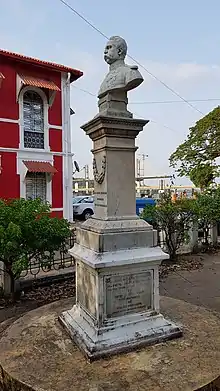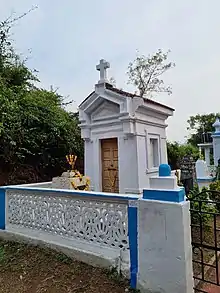Miguel Caetano Dias | |
|---|---|
| Born | 9 July 1854 |
| Died | 26 July 1936 (aged 82) |
| Known for | Contributions to medicine in Goa, India |
| Spouse | Maria Veronica da Silva e Dias |
| Children | 8 |
| Awards | Cavaleiro, Official e Comendador da Real Ordem Militar de S. Bento de Aviz. |

Miguel Caetano Dias ComA (9 July 1854 - 26 July 1936) was a medical doctor best known for his roles as chief of health services in Goa (Estado da Índia Portuguesa) and director of the Medical School of Goa (Escola Médico-Cirúrgica de Goa). In these roles, he was widely recognised for waging successful vaccination and sanitation campaigns, and was also instrumental in advocating against the closure of the medical school.[1][2][3][4]
Early life
Dias was one of five children born to Manuel Francisco Dias and Escolastica Fernandes e Dias in St Estevam , an island in Goa, India. The humble circumstances of his childhood are often mentioned in later accounts of his achievements.[2][4]
His brother João Vicente Santana Dias, a Major in the Portuguese Army, is credited with helping him enrol at the Faculty of Medicine of the University of Lisbon where he graduated with distinction in 1882.[2] Upon graduation, he joined the Portuguese Army as part of the military medical cadre in Mozambique.
Career
After spending five years in Mozambique, Dias was transferred to Goa in 1888. Around this time, the Portuguese authorities were seriously considering closing the Medical School of Goa with an inspection conducted by the Portuguese doctor Cesar Gomes Barbosa in 1897 recommending shutting the school down permanently.[5] However, in 1902 the Portuguese government finally voted to keep the school open with arguments put forth by the prominent physician and politician Miguel Bombarda that the school would be the ideal place to train doctors for the colonies.[6] While Bombarda did not acknowledge it, his arguments were previously put forth by native born Goan doctors including Dias himself who wrote in 1902.[7]
The Medical Surgical School of Nova Goa, situated in a country where the reigning diseases reflect the tropical climate, acts to foster the training of colonial doctors in such conditions, and so assists with the demands of African colonization at little cost for the treasury.
— Estado da India Portuguesa, “Relatorio do Serviço de Saúde referido ao anno de 1902”, signed by Miguel Caetano Dias, Head of the Health Services. Arquivo Histórico Ultramarino, Índia, Serviço de Saúde, maço 1988
This vote coincided with the mandate of Dias who was appointed the director of the health services in Goa and director of the Medical School of Goa in 1902, only the second native born Goan to achieve this position in the colonial administration after his predecessor Rafael Pereira from Benaulim, Salcette.[2] Though a native Christian, Dias was not from the elite social circles from which his predecessors had originated and is recognised as having worked his way towards social and professional recognition through personal effort and merit, in what was at the time, a highly stratified society.[1][2]
Dias was a strong proponent of modern European medicine and vaccination in particular, as opposed to the variolation or inoculation techniques that were common among the local population. He recommended the creation of vaccine parks in different districts despite the challenge this was to local beliefs about ritual and body pollution.[2] He often condemned the latter in his writings.
"unless the vaccine method exhibits some good results, there is no chance that the people will take it instead of inoculation: the bulk of the population since immemorial times has shown a blind predilection and trust in the inoculation of the variolic virus to the detriment of the Jennerian vaccine, because this goes against their religious beliefs (. . .) and because they do not believe in its prophylactic efficiency, which is not surprising, for the people, for whom science is still a mystery, can’t be persuaded of the vaccine’s superiority until they see it with their own eyes"
— Estado da India Portuguesa, “Relatorio do Serviço de Saúde referido ao anno de 1902”, signed by Miguel Caetano Dias, Head of the Health Services. Arquivo Histórico Ultramarino, Índia, Serviço de Saúde, maço 1988
His anti-plague campaigns and sanitary policies played a large part in the adoption of modern European medicine across Goan society.[1] His tenure ended in 1913 and he was succeeded by José Maria da Costa Álvares.[8]
Dias later became actively involved in politics and was appointed the President of the first Provincial Congress of Goa and also mayor of the Municipal Council of Ilhas.[9]
Awards and recognition
In recognition for his services to public health, Dias was made a Knight of the Military Order of Aviz (Cavaleiro, Official e Comendador da Real Ordem Militar de S. Bento de Aviz).
A bust of Dias was installed in the premises of the Medical School of Goa and was later shifted to the front of his residence upon his death, where it still stands today. The inscription on the bust reads "Ao Grande Cirurgião. Homenagem Dos Seus Concidadãos (To the great surgeon. Homage from your fellow citizens)"
Luís de Menezes Braganza the prominent Indian journalist and anti-colonial activist from Goa often wrote of contemporaries he admired in Pracasha, a Konkani language daily. Of Dias, he wrote that though Dias did not come from an aristocratic family, he served his people and his country well. He also wrote that Dias was not very polished in his manners and etiquette but the good of his people was always uppermost in his mind.[10]
Personal life
Dias married Maria Veronica da Silva and had eight children Victor Manuel Dias, Luis Gonzaga Bismarck Dias, Alvaro Jose Maria da Silva Dias, Antonio Francisco Dias, Ernesto Dias, Albertina Lavinia Escolastica Dias e Afonso, Aurea Dias e Lobo and Alice Leonor Brigida Dias e Fialho.
A number of his children went on to achieve individual renown in their own fields of study and practice.[4][11]
His bought the Casa da Moeda in Panjim, Goa where his descendants continue to live and opposite which his statue is installed. He also purchased a large tract of land in Naroa, an island along the river Mandovi opposite his home island of St. Estevam, where he built a Chapel.[12]
Death
Dias died in 1936 and was buried in his native St Estevam where his family grave occupies a prominent place in the front of the cemetery.

References
- 1 2 3 Bala, Poonam (12 April 2012). Contesting Colonial Authority: Medicine and Indigenous Responses in Nineteenth- and Twentieth-Century India. United States of America: Lexington Books. p. 24. ISBN 978-0-7391-7023-6.
- 1 2 3 4 5 6 Bastos, Cristiana (2009). "Borrowing, Adapting, and Learning the Practices of Smallpox: Notes from Colonial Goa". Bulletin of the History of Medicine. 83 (1, Special Issue: Reassessing): 147, 156, 157. JSTOR 44448718.
- ↑ "Goa Medical College: Illustrious alumni | Veena Patwardhan". Retrieved 9 November 2019.
- 1 2 3 "NRI Commission of Goa". nri.goa.gov.in. Retrieved 9 November 2019.
- ↑ Gomes Barbosa, Cesar (1897). "Relatorio da Inspeccao ao Servico de Saude do Estado da India". AHU. s12, m1988.
- ↑ Bombarda, Miguel (1902). "A Escola de Nova Goa" A Medicina Contemporanea-hebdomanario portuguez de sciencias medicas. Serie II-tomo V,XX no.12. Portugal. pp. 93–95.
{{cite book}}: CS1 maint: location missing publisher (link) - ↑ Bastos, Cristiana (2002). "The inverted mirror: Dreams of imperial glory and tales of subalternity from the medical school of Goa1" (PDF). Etnografica. VI (1): 59–76. doi:10.4000/etnografica.2848. S2CID 11728609 – via CEAS-ISCTE.
- ↑ Roque, Ricardo (2004). "Seeds against smallpox: Joaquim Vás and the scientific translation of bananeira brava seeds in Goa, India (1894-1930)". História, Ciências, Saúde-Manguinhos. 11: 183–222. doi:10.1590/S0104-59702004000400010. PMID 15446280.
- ↑ "POLITICAL ACTIVISM AND CONSCIOUSNESS" (PDF).
- ↑ Braganca, Luis de Menezes (1931). Pracasha, AnoVIII, No746. Goa, India.
{{cite book}}: CS1 maint: location missing publisher (link) - ↑ J. Clement Vaz (1 January 1997). Profiles of Eminent Goans, Past and Present. Concept Publishing Company. pp. 210–. ISBN 978-81-7022-619-2. Retrieved 18 August 2012.
- ↑ Silveira, Lester (28 October 2019). "Re-discovering the private Chapel of Dr. Miguel Caetano Dias". The Balcao. Retrieved 9 November 2019.